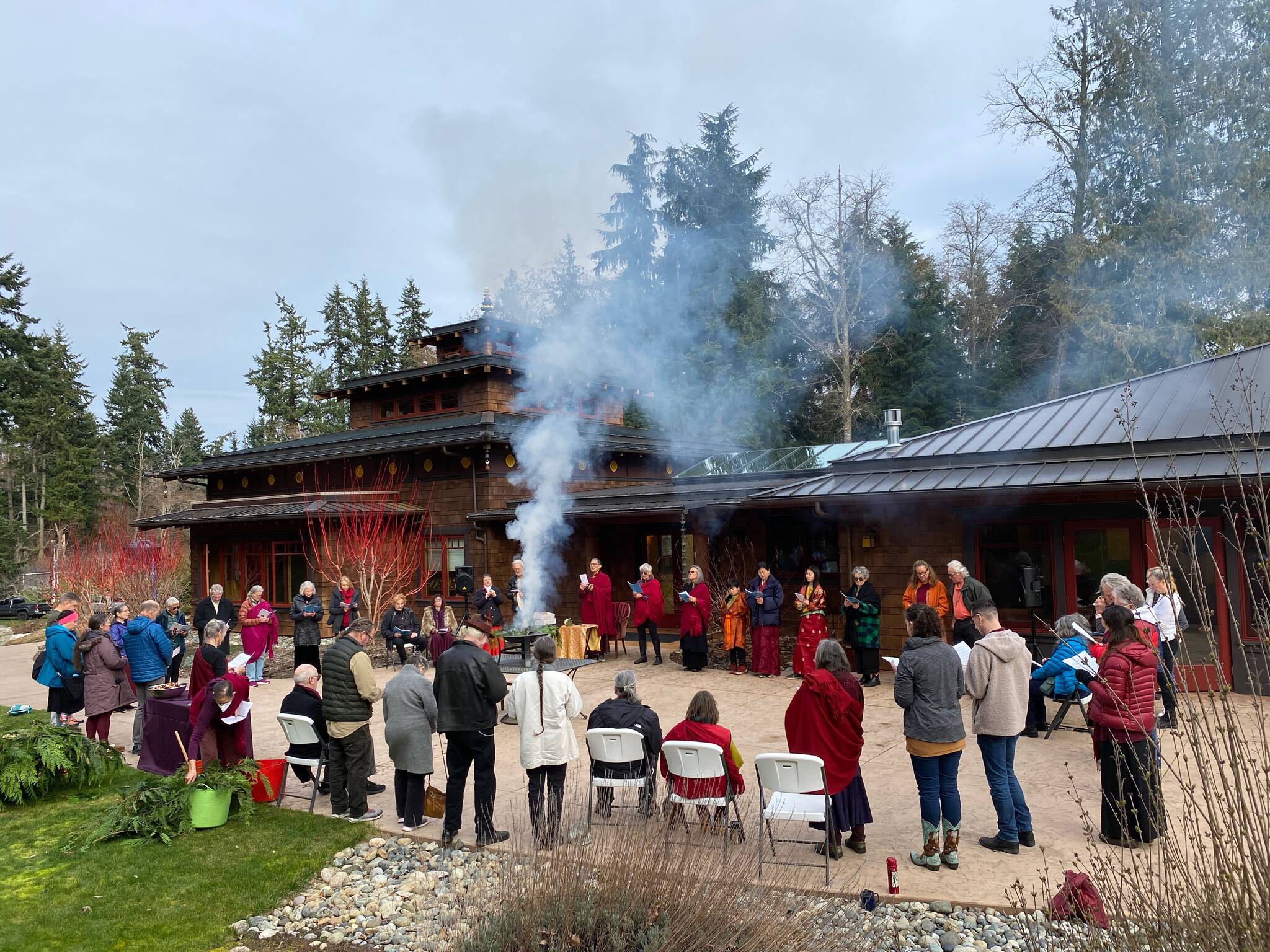When Karen Carbone, co-director of the Kilung Foundation in Langley, first stepped on the property of what would become the Phagtsok Gedun Choling Temple, she felt a feeling of home, she said. At that time, it was a double-wide trailer.
“Somehow in a prior life I had the good fortune to come to this place, and now I get to pick up again,” she said. “That’s a little more esoteric, but it’s also very real.”
The Tibetan Buddhist temple, as it stands today, opened its doors in 2019. The design was modeled off Tibetan monasteries, but instead of materials such as stone and clay, they used lumber, a tradition of the Pacific Northwest.
Coming off Losar or Tibetan New Year earlier this month, where Buddhist practitioners held a fire offering ceremony, gave long life blessings from Dza Kilung Rinpoche and taught about Tibetan culture, the Kilung Foundation has created opportunities for kids.
It started when the Whidbey Island Waldorf School approached Rinpoche about visiting the temple. Having two young children himself, he thought it was a great idea to create events for younger people and invite public school students as well, Carbone said.
The event begins with walking meditation, she said, to give students an opportunity to slow down and focus on the tasks before them instead of normal distractions. Then, Buddhists lead sacred dance lessons, craft prayer flags and cook traditional Tibetan food.
They weren’t sure how the kids would respond, said co-director Jeanne Lepisto, but generally both boys and girls have really loved it, some even returning multiple times. One 9-year-old boy said it was the best day of his life.
Long term, COVID-19 restrictions helped the Kilung sangha, or community, expand, Lepisto said. While the temple’s Monday evening meditation sessions went virtual, now there is an in-person and virtual option, which has allowed around 100 guests to participate from all over the world.
A strong focus of Vajrayana Buddhism and the Kilung Foundation is sangha, she said. Their Monday meditation sessions follow Rinpoche’s Seven Meditations, a year-long progression reaching its pinnacle in December.
The year starts with basic sitting meditation, then evolves to calm abiding meditation, where the practitioner begins to focus on the mind rather than body. Next comes refined basic sitting meditation, merging the previous two forms.
Later, Buddhists practice insight meditation, increasing their focus. Open heart-mind meditation develops feelings of kindness and compassion to all things, eliminating the separation between those inner and outer. Next comes pure mind meditation, building upon all mental focuses as a tool and not a distraction. The year ends with nonconceptual meditation, which relaxes the mind to focus on nothing. This transcends knowledge and leads toward ultimate awareness.
Rinpoche, who developed this practice, is the fifth incarnation of Dza Kilung Jigme Ngotsar, who discovered the dzogpachenpo or “Great Completion” tradition of Buddhism.
In some traditions, monks leave home and renounce society, Rinpoche said. Vajrayana is the opposite.
“We are also on the path of Buddha dharma, but we have even more opportunity to being big heart, openness to working with people and living with people in society,” he said.
In the Buddhist world, Whidbey is a rarer community than most. According to the 2020 U.S. Religion Census Report, just 0.02% of Island County is a practicing Buddhist.
Rinpoche found Whidbey by way of Seattle, Carbone said. Some of his students at the time lived on South Whidbey and invited him to “check out the energy.” He thought it was beautiful, and that the environment, people and place were a better fit. It took a slow progression over the years to grow to what it is today.
Vajrayana practices are a little less regimented than Zen, Carbone said. They focus on energy and intuition and bringing these concepts into habitual practice.
Vajrayana brings heightened awareness of daily practices, an ability to open and transform them, Lepisto said. Meditation, learning, hearing and reflecting can drive an “upward spiral” of awareness.
Lepisto is excited to return the temple grounds to a pre-COVID space, where guests can come even when there isn’t a formal event to just sit quietly, meditate and enjoy the natural environment.
“Let’s give ourselves a break in this busy time,” she said, “and shift that energy to take time for yourself, be gentle with yourself.”
Starting May 18, Rinpoche will lead two days of public teachings in person and over Zoom. It’s an opportunity to learn more about Tibetan Buddhism.
These types of experiences can be cathartic, Carbone said. Past members have broken into tears meeting Rinpoche, which they can only chalk up to past-life resonance.
Everyone has their own reasons to practice, she said, and doing so benefits the self and by extension the community, a main tenant.
“Even other people I may not like that much, or I might have some judgments about,” she said. “In fact, those people could sometimes be my best teachers.”
Personal growth tends to spread to others, she said.
“It’s not just Whidbey Islanders. It’s reaching out to all places, all universes and beyond,” she said. “That is the reason we do what we do, to improve ourselves, hopefully, but also so others might find their true nature.”



